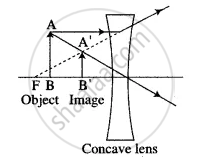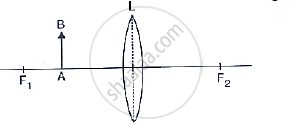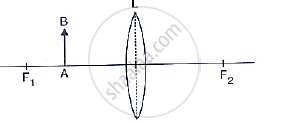Advertisements
Advertisements
Question
An object is placed in front of a lens between its optical centre and the focus and forms a virtual, erect, and diminished image. Draw a ray diagram to show the formation of the image with the above-stated characteristics.
Solution

APPEARS IN
RELATED QUESTIONS
The following diagram shows an object AB and a converging lens L with foci F1 and F2. Draw two rays from the object AB and complete the diagram to locate the position of the image CD. Also mark on the diagram the position of eye from where the image can be viewed.

The following diagram shows an object AB and a converging lens L with foci F1 and F2 State three characteristics of the image in relation to the object.

A lens forms an erect, magnified, and virtual image of an object. Where is the object placed in relation to the lens?
A lens forms an erect, magnified, and virtual image of an object. Name the device which uses this principle.
A magnifying glass forms ______.
The focal length of a convex lens is 25 cm. At what distance from the optical centre of the lens an object be placed to obtain a virtual image of twice the size?
Define the term magnifying power of a simple microscope. How does it depend on the focal length of the lens used?
What is a magnifying glass (or a simple microscope)? Draw a ray diagram to show how a convex lens may be used as a magnifying glass. Where should the object be placed? State three characteristics of the image formed.
(i) Draw a ray diagram to show how the lens can be used as a ‘magnifying glass’? State the nature of the lens.
(ii) In what respect does the image in (i) above different from the image formed by a concave lens?
Write an expression for the magnifying power of a simple microscope. How can it be increased?
